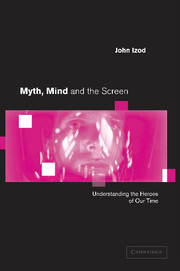Book contents
- Frontmatter
- Contents
- Acknowledgments
- Introduction
- 1 Jungian theory, textual analysis and audience play
- 2 Archetypal images: signification and the psyche
- 3 Archetypal images: symbols and the cultural unconscious
- 4 The Piano, the animus and colonial experience
- 5 The pop star as icon
- 6 The quest of a female hero: The Silence of the Lambs
- 7 Television sport and the sacrificial hero
- 8 The polycentred self: The Passion of Darkly Noon
- 9 Haunted: searching for the whole self
- 10 Transforming the final ghost: the god within
- Conclusion
- Filmography
- Glossary of Jungian and related terms
- References
- Index
2 - Archetypal images: signification and the psyche
Published online by Cambridge University Press: 22 September 2009
- Frontmatter
- Contents
- Acknowledgments
- Introduction
- 1 Jungian theory, textual analysis and audience play
- 2 Archetypal images: signification and the psyche
- 3 Archetypal images: symbols and the cultural unconscious
- 4 The Piano, the animus and colonial experience
- 5 The pop star as icon
- 6 The quest of a female hero: The Silence of the Lambs
- 7 Television sport and the sacrificial hero
- 8 The polycentred self: The Passion of Darkly Noon
- 9 Haunted: searching for the whole self
- 10 Transforming the final ghost: the god within
- Conclusion
- Filmography
- Glossary of Jungian and related terms
- References
- Index
Summary
Jung developed a relatively simple outline model of the psyche which he thought of as consisting in three concentric spheres. Reading from the outermost inwards, they were the conscious mind, the personal unconscious and the collective or impersonal unconscious. Given the intensity of debate which his thought has aroused over the years, it is important to remember that his model was designed to aid understanding, not to enforce a dogma. Jung himself was well aware that there were no hard boundaries between the various spheres that he had posited. Rather, they were permeable such that energies stirred in any one of the mind's spheres could trouble the quietude of the others. It would not have worried him that some of his successors have, as we shall see, suggested a number of modifications to his original classical model. These include the introduction of a fourth sphere known as the cultural or group unconscious, located between the personal and the collective realms.
Of the two spheres of the unconscious posited by Jung himself, the transpersonal or collective is the one which is remembered as peculiarly his own construct. This is not because the other realm, that of the personal unconscious, lacks importance in the life of human beings. Rather it is because the latter resembles the Freudian subconscious in many of its functions. Jung conceived of it as the repository of contents generated through the circumstances of the individual's existence.
- Type
- Chapter
- Information
- Myth, Mind and the ScreenUnderstanding the Heroes of our Time, pp. 33 - 46Publisher: Cambridge University PressPrint publication year: 2001



